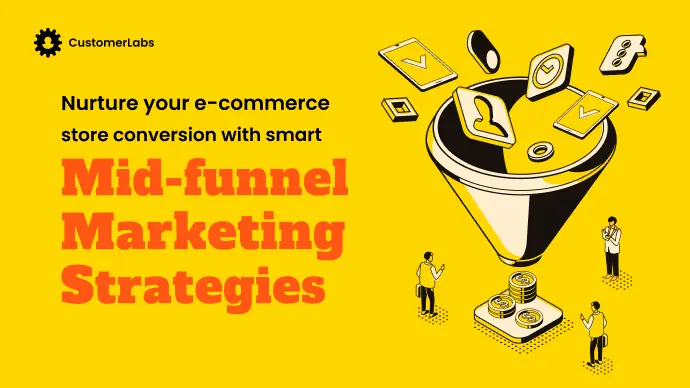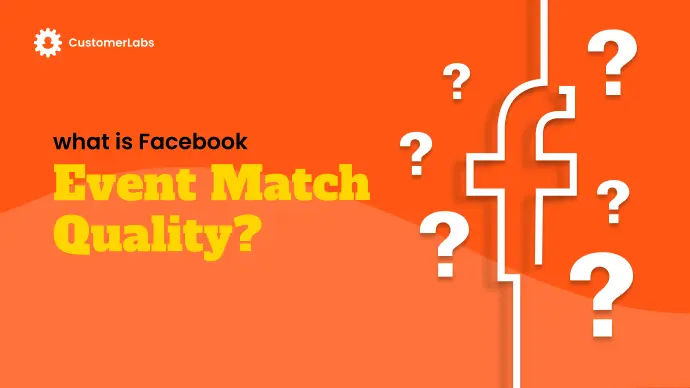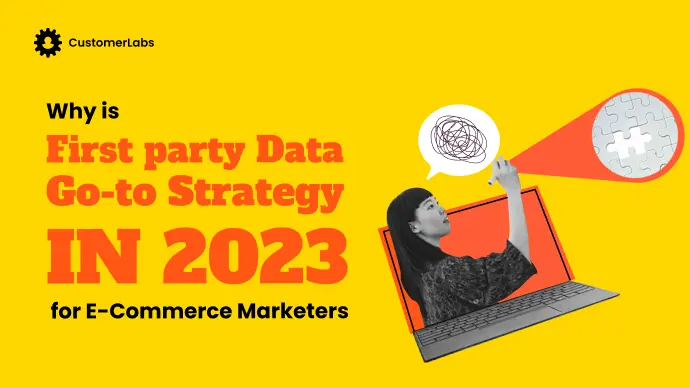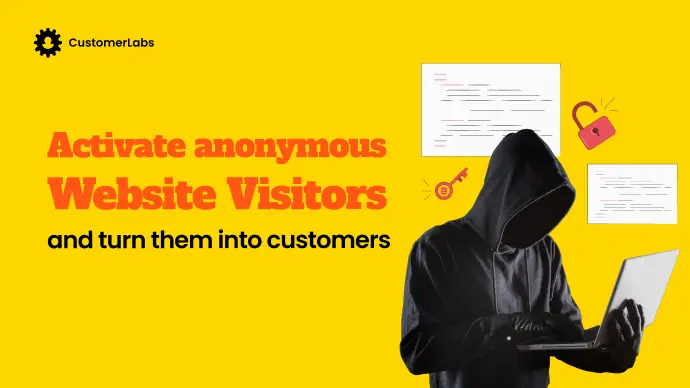
Every day, thousands of people land on your website, browse through, and leave without providing any information. These people are called anonymous website visitors. They might have come from your marketing emails, organic search, social media, paid ads, and all your other top-of-the-funnel campaigns.
If you are unsuccessful in pushing these anonymous website visitors through your funnel, all the top-of-the-funnel efforts go in vain. It is because you fail in converting high-intent users into customers.
Did you know?: On average, it takes 8 touchpoints to convert a user into a customer.
All these efforts go in vain when you under-utilize the incoming visitors to the website and do not activate them.
Importance of Anonymous Website Visitors
Did you know? Around 97 to 98% of the website visitors are anonymous!
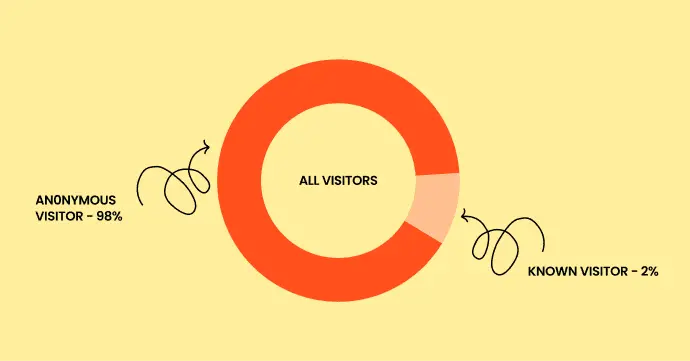
In most of your remarketing efforts, you can interact, engage with, and activate only the known website visitors. Only 2 to 3% of your total website visitors are known visitors.
How about those 98% of your anonymous website visitors, whose details you do not collect for no good reason?
What if I said, you can activate these anonymous users and add at least around 10 to 15% incremental revenue?
Leave the revenue part as it might sound like magic.
What if I said – you can pull off at least 2 to 5% more conversions from these anonymous (unknown) website visitors?
Sounds reasonable?
Yes!
It is possible….
Which businesses can activate anonymous users?
I see many people searching for the terms –
- ‘B2B anonymous user identification’,
- ‘eCommerce anonymous user activation’,
- ‘anonymous website visitor tracking’,
- ‘identify anonymous website visitors’,
- ‘activate full-funnel’,
- ‘activate anonymous website visitors’, and many more.
These searches show that every business in the digital space wants to turn anonymous users into known users.
Note: Identifying and activating anonymous website visitors has become crucial for the
- Healthcare industry,
- financial industry, and
- Every other industry
that faces trouble collecting user data amidst the cookieless era.
You might be wondering – “Okay, all this is fine. But who are these anonymous visitors?”
Let’s have a look at the definition, and how these anonymous website visitors are different from known users.
Who Are Anonymous Website Visitors?
Anonymous website visitors are those users
- who do not sign in to your website, or provide any information on your website,
- browse through your website without providing any personal website, and
- have a decent activity on your website without logging in.
Adding to this, they do not share any known information such as name, email address, phone number, location, etc., with your business. So, basically, the unknown users are the anonymous users.
Difference between anonymous and known users
| Anonymous Website Visitors | Known Users | |
| Who are they? | Anonymous website visitors may be either new or returning visitors to your website whose personal information is not available. | Known website visitors are existing customers or users whose personally identifiable information (PII) is available. |
| What other information can you get apart from name, email address, and phone number | Complete user behavior across the website, demographics, and other IDs** | Cart behavior (if logged in), purchase behavior, and demographics |
| What’s the difference? | They do not login or sign in to your website or do not make the purchase. Therefore, their name, email ID, etc., are not available | They login / sign in to your website or provide the personal information like name, email ID etc., in some or the other way |
| In general, how is the information collected from them? | Only advanced technology can collect details like demographics, age, etc., from anonymous website visitors. Earlier, third-party cookies used to collect and store these users’ data. | As the users are logged in, their known information is directly stored in the systems such as CRMs, and used. |
| How are they identified | The ad platforms collect the certain IDs of these users and try to map these anonymous website visitors with the accounts in their database | The ad platforms identify the known users using their name, email address, phone number, etc. |
| How are they activated | Pixel code of the ad platforms collect and send this data* | They are directly activated either through ad platforms or through email marketing campaigns or WhatsApp marketing campaigns. |
| Can you activate them now? | No** Unless you have advanced technology like CustomerLabs 1PD Ops, that lets you activate anonymous website visitors. | Yes. You can use email marketing platforms, known user 1PD Ops, like Klaviyo, etc. |
| How do you enhance? | If you use advanced identity resolution technology, adding the details to these anonymous profiles and later on, at some point, when the user converts, it will be a boost to the business. For example, CustomerLabs 1PD Ops’ stitcher helps you with mapping the external IDs, making a 360-degree profile of the | Combining all known user touchpoints across the website, the offline stores, events, customer support, etc., to get a complete customer journey will enhance the |
*With the onset of third-party cookie deprecation, ad platforms can no more activate these anonymous website visitors
**You can still activate the anonymous website visitors using CustomerLabs 1PD Ops – the only patented technology to activate the anonymous website visitors on ad platforms using multiple IDs.
Why ad platforms cannot activate anonymous visitors?
The buzz around the activation of these anonymous website visitors kicked in around 2019 and afterward. Does that date recall something? The law that has shaken the entire digital world – GDPR came into existence in 2018.
Following GDPR, to offer more privacy to the users, Apple launched iOS14.5. Then came another major update that crashed the ad platforms’ ability to collect anonymous user data – the third-party cookie deprecation in all the major browsers including Google Chrome.

All these data privacy updates offered an extra layer of privacy to the users while they deprived the ad platforms from collecting and storing anonymous user behavior data.
Here’s what happens when ad platforms cannot activate anonymous website visitors
Ad platforms were unable to retarget these anonymous website visitors, as they were unable to collect and store their data. This resulted in a huge dip in the marketing campaign performance. Those marketers, who entered the digital marketing field after 2021, might not know this because they did not see how the ad performance was before 2021. So, they tend to believe that everything is normal while it is not.
Facebook (Meta) can store the event data (user behavioral data including anonymous website visitor behavior) for not more than 28 days. It becomes very difficult for marketers like you to implement advanced audience segmentation strategies.
For example, you cannot retarget a user who has viewed a product more than 3 times but did not purchase it in the last 45 days. [A user who viewed the product 3 times are high-intent users. And need a little nurturing to push them to make a purchase].
But What Happens In a Traditional e-commerce Marketing Funnel?
Many digital marketers believe that the campaign structure should split into Top and Bottom funnel campaigns.
Top funnel campaigns are focused on age groups, demographics, and interests powered by third-party data i.e. ad platforms majorly.
Bottom-funnel campaigns, focus on retargeting to convert cart abandoners and checkout page abandoners in the last 7 to 21 days.
For example, brands will spend only 2 cents on engaging and converting anonymous visitors for every $1.00 spent on acquisition.
And these brands will dedicate most of their time and resources to converting known visitors (2%) which is considered to be a great conversion metric.
Therefore, retargeting campaigns really work and help businesses push those 2% users to make purchase. But for retargeting anonymous users i.e., the 98% of the users, the retargeting campaigns failed!
Why Are Retargeting Ad Campaigns an Epic Fail?
Let’s say, you wanted to segment the “product_viewed more than 3 times in the last 45 days”. You want to now run a personalized ad campaign on Facebook to make them purchase that product they viewed. How would you do that? You use the audience data for the last 45 days, send those custom audiences to Meta and run retargeting campaign.
But the custom audience match rate for the segment “product_viewed” on Facebook is very poor
When you upload the 20k users of the custom audience list “product viewed audience” in the audience manager, Facebook could match only 25%. That means Meta identified only 5k users from the total audience size of 20k.
Why Facebook Custom Audience match rate is poor?
Before iOS14.5+ update, Facebook was your data host. It had access to everything about your website including the users’ behavior (anonymous website visitor behavior too). You could certainly target the audience, segment them and set up the ad campaign on Facebook itself. So this retargeting campaign yields a decent performance as well as revenue.
Post iOS’14+ update:
Facebook has limited access to the user behavior data. It is because third-party data tracking is not the right way, moving ahead into 2024, the era of data privacy. And the browsers, apps, and all other platforms do not allow user tracking anymore. So, Facebook became merely an advertising tool and not your data host.
Adding to this, Meta is also banned from behavioral targeting in the European Union. All these have caused data crunch to Meta.
With lesser access to behavioral data, and limitations in pixel tracking, the match rates crumbled. They crippled down to less than 25%. This resulted in shrinking the remarketing audience size substantially. There are instances you won’t be having enough audience to run remarketing campaigns.
One other reason for the retargeting audience size to shrink is – Meta offered paid subscription in EEA, EU, and the UK. Therefore, Meta is now not collecting the data of these paid users.
98% of the website visitors are ignored or left unnoticed and are anonymous visitors or anonymous potential leads. As the obsession revolves around the top and the bottom of the funnel, the majority of website traffic (anonymous visitors) is stuck in the mid-funnel.
Anonymous Website Visitors Are Stuck In mid-funnel Because
No user behavior data:
When a user lands on the website, they perform various actions and events. But the information that most brands collect is the basics – demographics, age, name, etc.
With this information, all the users are treated and targeted in the same way with no personalized engagement.
For instance, if a user has viewed a couple of products in the footwear category, and left the page, we could segment and retarget them like “product page visited less than 3 times” with messaging relevant to them that brings them back to the site.
i.e.we could segment the website visitors based on user behavior and distribute content that helps the user to move towards purchase.
Let’s imagine, hypothetically, you have the user behavior data of the users across the funnel. But the re-targeting ad campaign still is an epic fail.

Activate The Anonymous Website Visitors To Increase Your Conversion Rates
When we say, first-party data, it is more than an email id, contact number, form-filled, and CRM.
Anybody who stumbles on your website is your first-party data.
First-party data is firsthand information of your website visitors. It is more valuable than less direct information collected from other third parties and can be used to improve marketing, sales, and product development efforts.
User Data Collection
Data is collected from the website visitors through cookies from the website, CRM platforms, social media profiles, and mid-funnel audiences i.e., your anonymous website visitors. The majority of the anonymous visitors are the high-intent audience who can be nurtured and pushed to the bottom of the funnel.
These anonymous website visitors’ data is collected using server-side tracking, to mitigate signal loss using CustomerLabs 1PD Ops.
User Data Activation
Facebook Conversions API, Google’s Conversion Tracking with enhanced conversions, among others are the tools that help you send high-quality first-party data, user behavior (including anonymous website visitors collected using CustomerLabs 1PD Ops). Thus, you can activate anonymous website visitors across ad platforms. Activating first-party data on ad platforms boosts business revenues. Let’s see how it’s done on Facebook.
First-party data improves Facebook’s custom audience match rate
Like we distinguish known visitors and anonymous users, we collect certain information from both. Along with the first name, email id, and demographics, we also collect Browser ID, Click ID, IP address, User-agent, Facebook ID, Google ID, etc of both anonymous and known users.
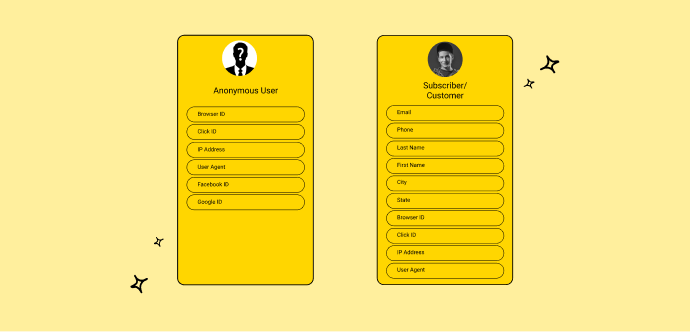
With the anonymous user data, we collect, Facebook could easily match the audience.
Read here to know how first-party data improved the Facebook custom audience match rate beyond 80%
Improve event match quality
First of all, event match quality indicates how effectively the customer information is sent from your server to a Facebook account. High-quality event matching will improve the campaign performance, and attribution and decrease cost per action.
We collect all the parameters that are required on Facebook to improve match quality. With the first-party audience data, we could pull 100 % match rates.
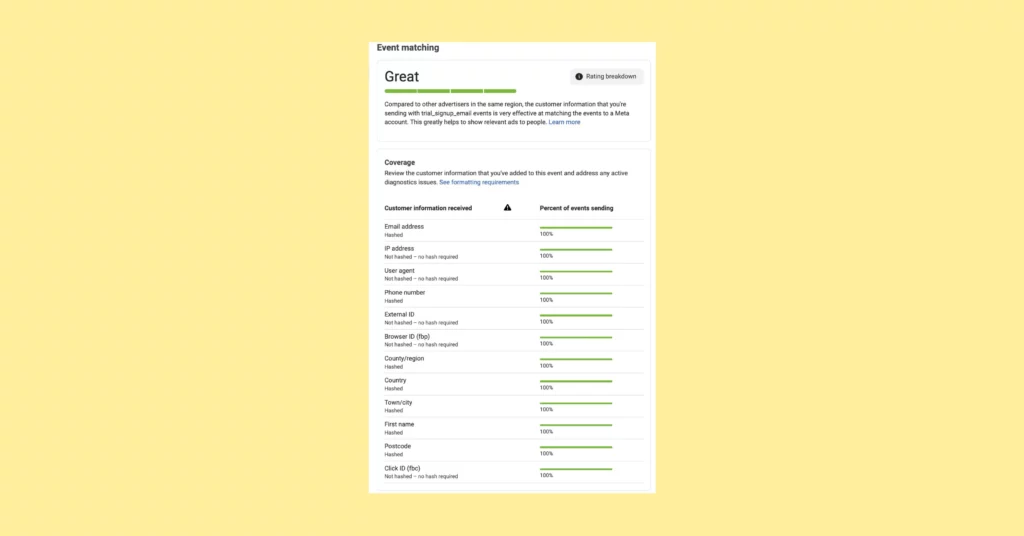
Customer information parameters help you match your events to a Facebook account so you can attribute conversions to your ads and deliver them to people who are most likely to make a conversion. To know more about event match quality and how to improve it.
Match Rate experiment: What works better – First-party data vs Facebook pixel data
Going forward, there won’t be third-party cookie tracking which makes it obvious for businesses to start collecting our first-party data.
To back up the above statement, we did an experiment with Facebook pixel data and first-party data of our very own website blog visitors.
Using the pixel’s data, Facebook could match only 25% of the users from the total audience size of 16k whereas with first-party data- Facebook could match beyond 90%.
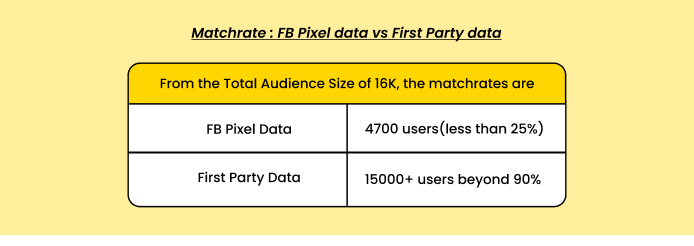
Match Rate experiment on Google Ads for anonymous website visitors
Google match rates for anonymous users increased when we experimented by sending first-party data to Google.
Google can easily identify the people in the customer list with first-party data, whereas this is not the case with third-party data.
Third-party data often comes from a variety of sources across the web, which is then aggregated and segmented, and sold to other advertisers.
But, first-party data is your own data collected by yourselves thereby it could be more relevant in targeting your audience.
Plus, first-party data sent to Google is not just for identification and activation of anonymous website visitors, it is also to train the ad algorithm on first-party audience signals.
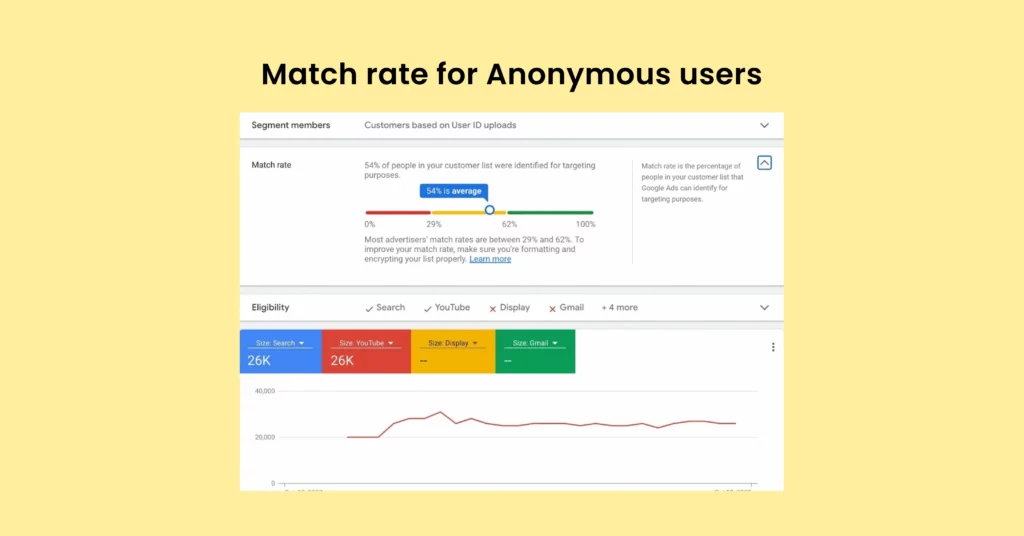
Segment your anonymous website visitor based on user behavior:
There are some default segments used by most e-commerce marketers like added-to carts, wishlists, and checkouts which are ultimately the bottom-of-the-funnel segments.
But the mid-funnel audience needs to be treated a little differently.
Segment the anonymous visitors stuck in mid-funnel: “Personalised engagement”
- Product _viewed_more than 3times
- Cart_abandoned for more than 30 days
- Product_viewed_not_ added_to_cart
- Segment the users who have added to the Wishlist more than 10 products
- Segment the users who are first-time visitors and provide them “newbie discount codes”
You can also do advanced segmentation based on user behavior and predict the next potential action the user would make. For example, you can predict the users who’re likely to purchase in 10 days. Check out the various techniques and advanced audience segmenting you could do.
Note: Check out the case study of India’s leading fashion brand, which activated its mid-full audience and improved its custom audience match rate beyond 80% using first-party data.
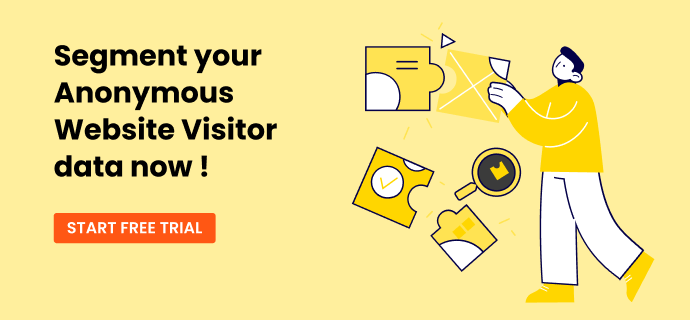
Now, how to make Facebook deliver your ad to the right people at the right time?
Facebook said, “When optimizing for conversions, we recommend choosing one that happens about 50 times per week at a minimum. Our system needs that many to learn from. Our system needs to learn so that it can deliver your ad to the right people at the right time to get you the best results.”
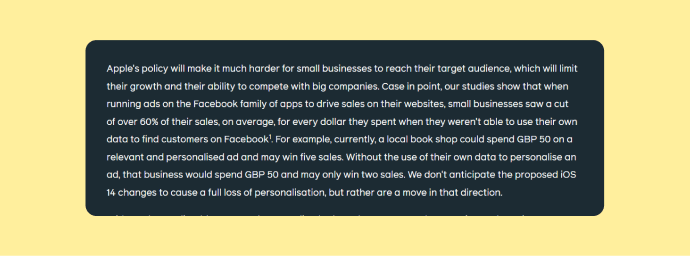
Strategies to improve your Facebook campaign optimization:
- Optimize your e-commerce campaigns for micro-conversions
Micro-conversions are simple actions on your website/any landing page. It is something a user does on your website that shows a genuine interest in your offer.
Optimizing your ad campaign for micro-conversions for e-commerce or B2B or any type of business will help Facebook to optimize and target the right audience.
For example, an e-commerce marketer, can optimize the conversion event to “added_to_cart” rather than “purchased” which will still drive users with the intent of buying.
- Optimize your B2B campaigns for micro-conversions
For B2B businesses, marketers can optimize the campaign to micro-conversion events like “scrolled the page up to 50%” rather than “schedule a demo” or “survey attended” which will still offer the high intent audience.

User Profiling of Anonymous Website Visitors
All the above mentioned strategies are very much possible. But, for that to happen, you need to
- Map your entire customers’ journey,
- Unify their touchpoints using stitcher, the advanced identity resolution technology,
- Leverage identity graph with external IDs
- Connect the CRM systems, and once the anonymous website visitor is converted into known user, the CRM data will map with this user’s data giving the complete customer journey,
- Send the data along with these IDs in a streamlined manner through server-side connections to the ad platforms.
Key Takeaways
In the world of growing concerns around privacy, it’s time you start collecting your own customer behavior data i.e. first-party data; and activate your audience throughout the marketing funnel to give a personalized experience for the users.
Anonymous website visitors are the high-intent potential purchasers who are ignored and left unnoticed. Collecting anonymous website visitor data i.e. first-party data is cheaper, accurate, and reliable for any business.

